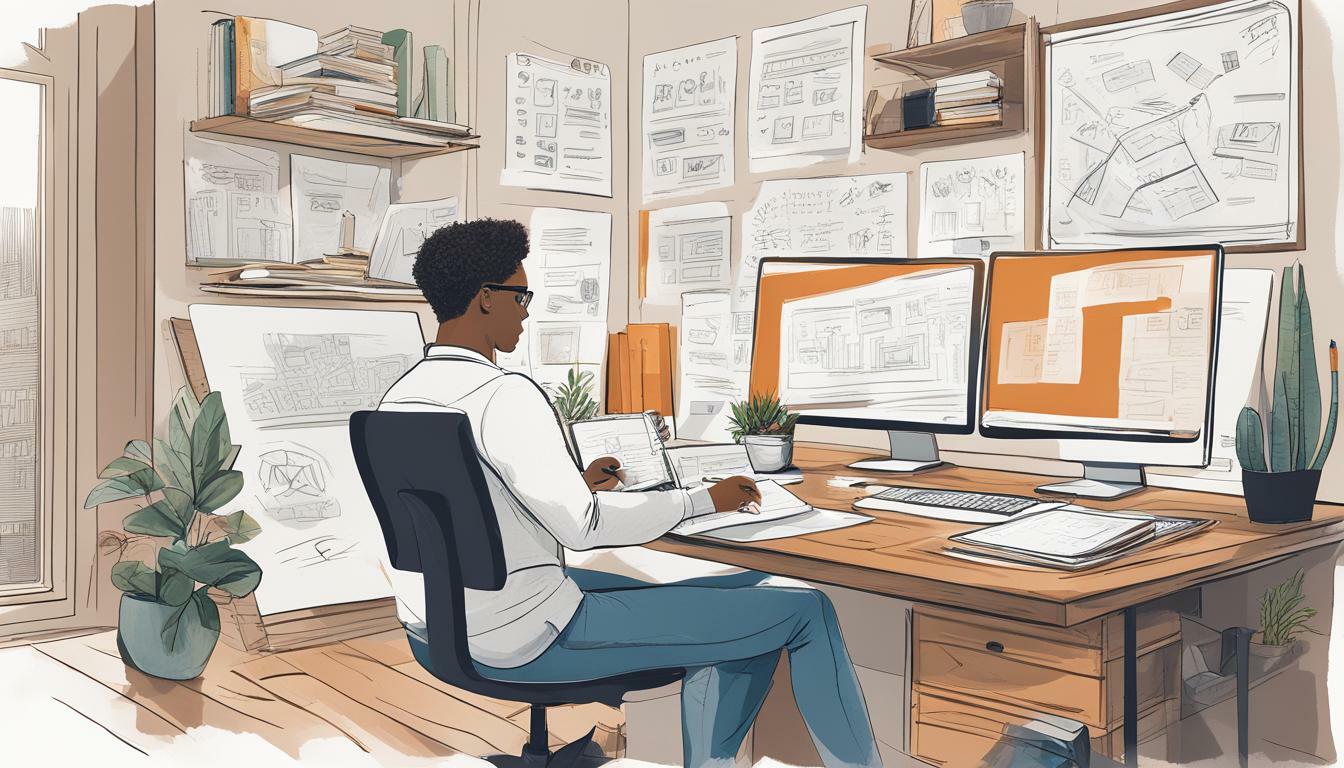
Are you passionate about creating seamless and intuitive user experiences? Do you love designing interfaces that are as visually appealing as they are functional? If so, then a career in UI/UX design may be just what you’re looking for.
UI/UX design is a constantly evolving field that offers endless opportunities for growth and creativity. Whether you’re just starting out or looking to take your design skills to the next level, this guide will provide you with the information and resources you need to become a professional UI/UX designer.
In this article, we’ll explore the foundations of UI/UX design, essential skills, and knowledge needed to succeed in the industry. We’ll also provide advice on creating an impressive portfolio, mastering design tools and software, collaborating with developers and stakeholders, and networking within the design community.
By the end of this guide, you’ll have a clear understanding of what it takes to become a successful UI/UX designer and be ready to take the next steps in your career.
Key Takeaways:
- UI/UX design is a constantly evolving field with endless opportunities for growth and creativity.
- This guide will provide you with the information and resources you need to become a professional UI/UX designer.
- You’ll learn about the foundations of UI/UX design, essential skills and knowledge, creating an impressive portfolio, mastering design tools and software, collaborating with developers and stakeholders, and networking within the design community.
- By the end of this guide, you’ll have a clear understanding of what it takes to become a successful UI/UX designer and be ready to take the next steps in your career.
Understanding UI/UX Design
UI/UX design stands for user interface and user experience design. It encompasses the visual and interactive aspects of digital products and services, focusing on creating seamless and enjoyable user experiences.
Becoming a successful UI/UX designer requires more than just an eye for design. It requires a deep understanding of user psychology, an ability to solve complex problems, and excellent communication skills.
UI/UX Design Tips
If you are interested in becoming a UI/UX designer, here are some tips to help you get started:
- Start by familiarizing yourself with the basics of design, such as color theory, typography, and layout.
- Practice designing interfaces for different platforms, such as mobile, web, and desktop.
- Learn about user research techniques, such as surveys, interviews, and usability tests, to inform your designs.
- Stay up-to-date with the latest design trends and technologies, and practice using new tools and software.
How to Become a UI/UX Designer
To become a UI/UX designer, you should have a combination of technical and soft skills. Technical skills include proficiency in design software, coding languages, and data analytics. Soft skills include communication, problem-solving, and project management.
You can gain these skills by pursuing a degree in design, taking online courses, attending workshops and conferences, and building a portfolio of design projects.
It’s important to remember that becoming a successful UI/UX designer takes time and dedication. Keep learning and practicing, and seek feedback from other designers and users to improve your skills and designs.
Building Your Skill Set
UI/UX design requires individuals to develop a diverse skill set to create effective and engaging user experiences. Fortunately, there are plenty of resources to help develop these skills, from online courses and tutorials to certifications and mentorship programs.
UI/UX Design Skills
Some of the essential skills for UI/UX design include:
- Problem-solving skills to identify and solve user experience challenges.
- User research skills to gain insights into user behavior, needs, and preferences.
- Interaction design skills to create intuitive and engaging user interfaces.
- Visual design skills to develop aesthetically pleasing and on-brand designs.
- Prototyping skills to test and iterate design concepts efficiently.
Developing these skills requires a combination of practice, learning, and feedback. It’s essential to keep up with the latest design trends and best practices by reading blogs, attending workshops, and engaging with the design community.
UI/UX Design Resources
There are many resources available to help develop UI/UX design skills, including:
- Industry-leading software programs, like Sketch and Figma, to create designs and prototypes.
- Online courses and tutorials to learn fundamental design concepts and tools, such as Udemy and LinkedIn Learning.
- Design communities that offer mentoring, networking, and resources, like Dribbble and Behance.
- Books and publications that explore design theory, trends, and case studies, such as “Don’t Make Me Think” by Steve Krug and “Designing for Interaction” by Dan Saffer.
UI/UX Design Courses and Certification
UI/UX design courses and certifications provide structured learning and credentialing opportunities for individuals interested in developing their design skills further. Some examples include:
| Program | Description |
|---|---|
| Interaction Design Foundation | An online organization that offers courses, mentorship, and certification programs in interaction design. |
| Nielsen Norman Group | A research and training organization that provides UX certification programs and in-depth courses. |
| General Assembly | An educational organization that offers intensive, hands-on courses in UX design and research. |
Certifications can demonstrate proficiency in specific areas of UX design and may be required by some employers.
Creating an Impressive Portfolio
As a UI/UX designer, having an impressive portfolio is crucial in showcasing your skills and attracting potential employers or clients. Your portfolio should be visually appealing and organized while highlighting your best work. Here are some tips for creating an impressive UI/UX design portfolio:
1. Curate your projects thoughtfully
Choose only your best projects to showcase in your portfolio. Include a variety of work to demonstrate your versatility and range of skills. Be sure to explain your thought process and design decisions for each project.
2. Consistency is key
Your portfolio should be consistent in design and style. Use the same color scheme and typography throughout your portfolio to create a cohesive look and feel.
3. Keep it simple
Avoid cluttering your portfolio with too much information or unnecessary design elements. Keep it simple and easy to navigate.
4. Show your process
Include sketches, wireframes, and prototypes to showcase your design process. This gives potential employers or clients insight into your creative thinking and problem-solving skills.
5. Get feedback
Show your portfolio to other designers and ask for feedback. This can help you improve your portfolio and make it more appealing to potential employers or clients.
Mastering Design Tools and Software
UI/UX design is heavily reliant on the use of various tools and software. Mastering these tools is crucial for becoming a successful professional designer. Having a strong understanding of these tools can help designers increase their productivity, streamline their workflow, and create visually appealing designs.
Sketch
Sketch is a popular vector graphics editor that is widely used in the UI/UX design industry. It offers a variety of features including symbols, vector editing tools, and plugins. Sketch’s user-friendly interface and intuitive design make it a preferred tool for many designers.
Adobe XD
Adobe XD is another popular design tool that is highly recommended for UI/UX designers. It allows designers to create wireframes, prototypes, and design specifications. Adobe XD’s easily customizable and highly responsive interface allows designers to create stunning designs with ease.
InVision Studio
InVision Studio is a powerful design and prototyping tool that enables designers to create engaging user experiences. It offers features like advanced animation, responsive design, and collaboration tools. InVision Studio’s flexible and scalable platform makes it an excellent tool for designing complex projects.
Figma
Figma is a collaborative design tool that enables designers to create designs with real-time feedback and collaboration. It offers features like vector networks, design systems, and prototyping. Figma’s cloud-based platform allows designers to work on the same project from anywhere in the world.
Mastering these tools and software can help designers create innovative designs that meet the needs of users and clients alike. Keeping up with the latest design trends and techniques and continually improving one’s skill set can help designers remain competitive in the industry.
Collaborating with Developers and Stakeholders
UI/UX design is a collaborative process that involves working with developers, product managers, stakeholders, and other team members. Effective communication and collaboration are key to ensuring successful design implementation and achieving the desired user experience.
To start, it’s essential to establish clear lines of communication and set expectations for each team member’s role and responsibilities. Regular meetings and check-ins can help keep everyone on the same page and provide opportunities to address any concerns or challenges that may arise.
Another strategy for effective collaboration is to involve developers and stakeholders early in the design process. By soliciting feedback and input from all team members, you can ensure that their needs and perspectives are considered and integrated into the final design.
It’s also important to be open to feedback and willing to iterate on designs as needed. Collaboration requires flexibility and a willingness to adapt to changing requirements and feedback from stakeholders.
Ultimately, successful collaboration requires a shared understanding of the project goals and a commitment to achieving them together. By building strong relationships and engaging in effective communication and collaboration, you can create high-quality user experiences that meet the needs of both users and stakeholders.
Keeping Up with UX Trends
UI/UX design is a constantly evolving field, with new trends emerging regularly. To stay relevant and competitive, it is crucial to stay up to date with the latest UX trends.
Keeping up with UX trends requires a willingness to learn and adapt. One common trend is the increasing use of virtual and augmented reality in UX design. Designers who are able to incorporate these technologies into their work will be in high demand.
Another trend is the importance of accessibility and inclusive design. Having a strong understanding of accessibility guidelines and designing for all users, including those with disabilities, is becoming increasingly important.
Finally, personalization is also a growing trend in UX design. Users expect a personalized experience, tailored to their unique needs and preferences. Designers who are able to create highly personalized experiences will be ahead of the curve.
By staying up to date with these UX trends and others, you will be well positioned to create successful and compelling user experiences.
Networking and Building Professional Relationships
Networking is a crucial aspect of building a successful career in UI/UX design. It not only helps you make connections with like-minded professionals but also opens up various opportunities for collaboration, mentorship, and personal growth. Here are some tips for effective networking:
- Join design organizations: Joining local or international design organizations can help you connect with other designers and stay up-to-date with industry news and events. Some popular organizations include AIGA, Interaction Design Association (IxDA), and User Experience Professionals Association (UXPA).
- Attend conferences and workshops: Attending conferences and workshops is an excellent way to meet new people and learn about the latest trends and techniques in UI/UX design. Some popular events include Smashing Conference, UX Week, and An Event Apart.
- Use social media: Social media platforms such as LinkedIn, Twitter, and Behance are great for networking and showcasing your work. Follow other designers and engage with their content to build relationships and expand your network.
- Collaborate on projects: Collaborating on projects with other designers, developers, or stakeholders can help you build meaningful relationships and gain new perspectives. Look for opportunities to work on open-source projects or join design hackathons and competitions.
- Volunteer: Volunteering for non-profit organizations or local events can help you meet new people while giving back to the community. Look for volunteer opportunities that align with your interests and skills, such as designing for a charity event or mentoring new designers.
Remember, networking is a two-way street. It’s not just about what you can get from others, but what you can give back as well. Be generous with your time and expertise, and don’t be afraid to ask for help or advice when you need it.
Landing Your Dream UI/UX Design Job
Embarking on a UI/UX design career can be challenging, but with the right approach, you can land your dream job. Here are some tips to help you navigate the job search process:
- Research potential employers: Take the time to research companies and their design teams to find a good fit for your skills and interests. Look for job openings on company websites, job boards, and social media.
- Create a killer resume and cover letter: Tailor your resume and cover letter to each job you apply for. Highlight your relevant experience and skills, and provide specific examples of your design work.
- Prepare for interviews: Research the company and its products, and prepare thoughtful questions to ask during the interview. Be ready to discuss your design process and your experience collaborating with others.
- Showcase your skills: Whether you’re interviewing or submitting your portfolio, make sure you’re showcasing your best work. Be prepared to explain your design decisions, and provide examples of how you’ve solved design challenges.
- Stay positive: Job searching can be frustrating at times, but don’t give up. Stay positive, and keep honing your skills and improving your portfolio.
By following these tips, you can increase your chances of landing your dream UI/UX design job. Stay persistent, continue learning, and keep pushing yourself to create great work.
Section 10: Conclusion
Embarking on a career in UI/UX design can be a challenging yet rewarding journey. By mastering your craft and staying updated with the latest trends and tools, you can become a professional UI/UX designer that delivers stunning and effective user experiences.
Throughout this guide, we’ve explored the foundations of UI/UX design and provided practical tips on how to build your skill set, create a portfolio, collaborate with others, stay updated on industry trends, network with professionals, and land your dream job.
So, if you’re passionate about delivering exceptional user experiences and creating intuitive and aesthetically pleasing designs, then let this guide be the starting point of your UI/UX design journey. Remember, becoming a professional UI/UX designer is not just about landing a job; it’s about dedicating yourself to a lifelong journey of continuous learning, growth, and creativity.
Thank you for reading this guide, and we wish you all the best in becoming a professional UI/UX designer.
FAQ
Q: What is UI/UX design?
A: UI/UX design refers to the process of creating user interfaces and experiences for digital products. It involves understanding user behavior, conducting research, and designing intuitive and visually appealing interfaces that enhance user satisfaction.
Q: Why is UI/UX design important?
A: UI/UX design is crucial because it directly impacts how users interact with a product. Well-designed interfaces and experiences can improve user satisfaction, increase engagement, and ultimately drive business success.
Q: What skills are needed to become a UI/UX designer?
A: To become a UI/UX designer, it is essential to have a combination of technical and soft skills. Technical skills include proficiency in design tools, prototyping, and coding. Soft skills such as empathy, problem-solving, and communication are also important for understanding user needs and collaborating with stakeholders.
Q: How can I build my UI/UX design skills?
A: Building UI/UX design skills can be done through a combination of self-study, online courses, workshops, and practice. Additionally, staying up-to-date with industry trends, participating in design challenges, and seeking feedback from experienced designers can also help improve your skills.
Q: What should I include in my UI/UX design portfolio?
A: Your UI/UX design portfolio should showcase a variety of projects that highlight your skills and expertise. Include case studies that explain your design process, problem-solving approach, and the impact of your designs. Visuals should be accompanied by clear explanations of the problem, solution, and the role you played in the project.
Q: Which design tools and software are commonly used in UI/UX design?
A: Popular design tools and software used in UI/UX design include Sketch, Adobe XD, Figma, InVision, and Axure. These tools allow designers to create wireframes, prototypes, and high-fidelity designs, enabling effective collaboration with developers and stakeholders.
Q: How can I collaborate effectively with developers and stakeholders?
A: Effective collaboration with developers and stakeholders in UI/UX design can be achieved through clear communication, empathy, active listening, and understanding each other’s constraints and objectives. Regular meetings, feedback sessions, and iterative design processes can also facilitate collaboration.
Q: How can I stay updated with UI/UX design trends?
A: Staying updated with UI/UX design trends requires continuous learning and engagement with the design community. Attend industry events, read design blogs and publications, participate in webinars, and join online design communities to stay informed about the latest trends and best practices.
Q: How can networking benefit my UI/UX design career?
A: Networking is valuable for UI/UX designers as it opens opportunities for collaboration, job referrals, and knowledge sharing. Building professional relationships with other designers, attending design meetups or conferences, and engaging with the design community can help expand your network and create new opportunities.
Q: How can I land my dream UI/UX design job?
A: To land a UI/UX design job, it is essential to craft a compelling resume and cover letter that highlight your relevant skills and experiences. Prepare for interviews by researching the company and practicing common design interview questions. Additionally, showcasing your skills through a strong portfolio and demonstrating your passion for UI/UX design can greatly increase your chances of landing your dream job.








